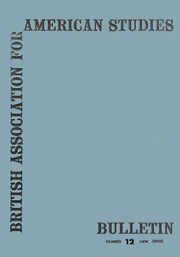Article contents
American ‘Isolationism’ in the 1920s: is it a useful concept?
Published online by Cambridge University Press: 17 February 2011
Extract
When I was first told, as a boy, how to keep my petty cash accounts, my instructor, in a rash moment, once let me see her own. The largest single item on the debit side stood opposite the initials “G.O.K.” Intrigued, I asked who the mysterious “Mr. K. was”. “No-one”, was the reply, “it stands for “God only knows”. The money is gone – on what I could not tell you. G.O.K. balances the accounts and takes care of my ignorance”.
- Type
- Research Article
- Information
- Copyright
- Copyright © British Association for American Studies 1963
References
REFERENCES
- 1
- Cited by




